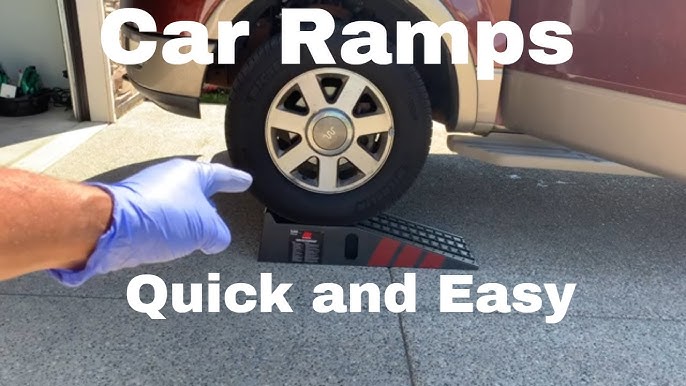Are you ready to tackle some car maintenance or simply need a way to safely elevate your vehicle? Installing car ramps is a straightforward solution that can make your life a whole lot easier.
Imagine the convenience of easily sliding under your car without the hassle of jacks or lifts. Whether you’re a seasoned DIY enthusiast or just getting started, learning how to install car ramps is a skill that can save you time and money.
In this guide, we’ll walk you through the simple steps to set up your car ramps safely and efficiently. You’ll gain confidence knowing that your vehicle is secure, allowing you to focus on the task at hand. So, are you ready to dive into the world of car ramps and unlock a new level of convenience? Keep reading to find out how!
Choosing The Right Car Ramps
Metal rampsare strong and last long. They can hold heavy cars. Plastic rampsare light and easy to move. They work well for smaller cars. Make sure the ramps do not crack or break easily. A good ramp can handle tough jobs.
Check the ramp’s weight limitbefore buying. Some ramps hold up to 3,000 pounds. Others can take even more weight. Always choose ramps that can support your car. Safe ramps prevent accidents. Protect your car and yourself.
Ramps need good grip. A slippery ramp is dangerous. Look for ramps with textured surfaces. This helps the car stay in place. Avoid ramps that slide or move. Safety is important. Your car should not roll off.

Credit: www.derekweaver.com
Preparing Your Vehicle And Workspace
Find a flat spot to park your car. Garages or driveways are best. Avoid hills or slopes. The car might roll and cause harm.
Get your ramps and wheel chocks ready. You also need a flashlight. Work gloves keep your hands safe. Safety glasses protect your eyes.
Look at your car manual. Know your car’s weight. Not all ramps fit every car. Choose ramps that can hold your car’s weight. Match ramp width to your car’s tires.
Positioning The Ramps
Make sure the car is on a flat ground. This helps in balancing. Place the ramps directly in front of each tire. Check if the ramps are straight. They should align with the tires. This ensures the car goes up easily. It’s crucial to prevent any accidents.
Ensure the ramps are steady. Press them down firmly. Safety is important. Avoid any movement when driving up. Some ramps have rubber grips. These grips prevent slipping. Always double-check before using the ramps. This helps in keeping everything safe.

Credit: www.youtube.com
Driving Onto The Ramps
Drive towards the ramps slowly. Keep your hands steady on the wheel. Eyes on the road, focus is important. The car should be straight. Avoid sudden movements. Sudden jerks may cause problems. A smooth approach helps greatly.
Stop when the car is centered. Use the mirrors to check. Ensure the front wheels are on the ramps. Double-check the alignment. This position keeps the car stable. Stability is key for safety. Engage the parking brake firmly.
Securing The Vehicle
Always engage the parking brake before using car ramps. This keeps the car from moving. Pull the brake lever tightly.
Some cars have a foot pedal for the brake. Press it down all the way. This step is very important for safety. Make sure the car is on a flat surface.
Wheel chocks are small blocks. They stop wheels from rolling. Place them behind the rear wheels.
Put one on each side. This adds extra safety. Always use wheel chocks, even if the parking brake is on. It’s a simple step but very important. Check they are firm and not moving.

Credit: www.youtube.com
Performing Maintenance Or Repairs
Installing car ramps is essential for vehicle maintenance or repairs, providing safe access to the undercarriage. Position ramps on a flat surface, ensuring alignment with the wheels for stability. Drive onto ramps slowly, checking that the vehicle is secure before starting any work underneath.
Safety Precautions
Always ensure the car is on a flat surface. This keeps the car stable. Use wheel chocks to stop the car from rolling. Wear gloves to protect your hands. Safety goggles shield your eyes. Check the ramps for cracks or damage. Damaged ramps can break and cause accidents.
Recommended Tools And Equipment
Car ramps are the main tool. Ensure they are strong enough for your car’s weight. A tire chock prevents the car from moving. Gloves protect your hands from dirt and scratches. Safety goggles guard your eyes from dust. Keep a flashlight handy for better visibility. It helps you see clearly under the car.
Removing The Vehicle From Ramps
Ensure the car is in reverse gearbefore moving. Slowly press the gas pedalto start reversing. Keep your eyes on the rearview mirror. Avoid sudden movements. Steer gently to maintain balance. Listen for any unusual noises. If unsure, stop and assess the situation.
Check ramps for damageafter use. Look for cracks or bends. Ensure bolts are tight. Make sure the surface is clean. Store ramps in a safe place. Clean any dirt or debris. Regular checks keep ramps safe.
Storing Your Car Ramps
Installing car ramps requires clear space for safe setup. Ensure the ground is stable and level. Align the ramps with your car’s wheels and drive slowly onto them. Proper storage of car ramps extends their lifespan. Keep them in a dry place to prevent rust and damage.
Cleaning And Maintenance
Car ramps need regular cleaning. Dust and dirt can damage them. Use a damp cloth to wipe away dirt. Avoid harsh chemicals; they can harm the ramp’s surface. Dry them completely before storing. This stops rust and keeps them strong.
Optimal Storage Solutions
Store car ramps in a dry place. Moisture can cause rust. Keep them off the ground. Use shelves or hang them on walls. This saves space and protects the ramps. Ensure the storage area is safe and secure.
Frequently Asked Questions
Can You Put Your Car On Ramps By Yourself?
Yes, you can put your car on ramps by yourself. Ensure the surface is level and stable. Align the ramps with your car’s wheels. Drive slowly up the ramps until your car is secure. Always apply the parking brake after positioning your vehicle on the ramps for safety.
How To Properly Put A Car On Ramps?
Position ramps on a flat surface, ensuring they’re aligned with tires. Drive forward slowly onto ramps. Stop when tires are centered. Engage parking brake and add wheel chocks for safety. Inspect stability before working under the car.
What Is The Maximum Slope For A Car Ramp?
The maximum slope for a car ramp is typically 1:12 or about 8. 33%. This ensures safe vehicle access. Always check local building codes for specific requirements. Proper slope design enhances usability and safety.
Do You Use Jack Stands With Car Ramps?
Use jack stands for extra safety with car ramps. Car ramps lift vehicles, while jack stands secure them. Always ensure car is stable before working underneath. Safety is crucial for vehicle maintenance.
Conclusion
Installing car ramps is simple with the right steps. Keep the area clear for safety. Use sturdy ramps for reliability. Double-check alignment before driving up. Secure your car with wheel chocks. Regular checks ensure ramps stay in good condition. Practice makes the process smoother.
Remember to follow each step carefully. Installing ramps safely protects both you and your car. A little caution goes a long way. Now, you’re ready to tackle this task confidently. Enjoy the benefits of well-installed car ramps. Happy car maintenance!
Hi I am Tamim Hasan, I am a normal person. I like to help people so I want to help you through the blog website. If anyone is benefiting through this blog website then you can help me by sharing comments.




